Let’s just get to the elephant in the room. Facebook ads are struggling.
Facebook is fighting a lawsuit against their reach metrics. And Facebook’s personalized ad campaign to combat Apple’s App Tracking Transparency (ATT) isn’t going well.
But the truth is that Facebook ads actually work.
With updates like exclusion controls, a new Conversions API that allows you to pull data directly from your server into Ads Manager, and transparency about the data Facebook is collecting, this social network doesn’t show any signs of slowing down.
Ahead, I’ll explain how and why Facebook ads work, different types of Facebook ads, and how to get started creating your first Facebook ad.
So, Do Facebook Ads Really Work?
The short answer: Yes. Facebook ads do really work.
Want proof?
In 30 days, this app generated 7,044 installs after spending $9,821 on Facebook ads.
BionicGym generated 9x ROI from their Facebook ads.
This company spent $300,774.82 to earn $3.64 million in revenue from Facebook ads.
Advertisement
Continue Reading Below
But, there’s a caveat in that Facebook ads work when your business is the right fit for Facebook ads. Depending on your industry, you want to consider if Facebook aligns with your business model.
Facebook ads are not always the answer for more traffic, clients, or sales. If you’re a business with a low cost of entry like an ecommerce pushing products or a SaaS that’s driving sign-ups, it can be difficult to find success.
If you’re unsure, start small. Stick to a cheap $5-$10 per day ad spend for 1-2 weeks to test.
A Quick Background of Facebook’s Ad Algorithm
Originally, when Facebook launched its ad algorithm, it was based on an auction. It gave priority to the highest bid.
However, in 2018, Mark Zuckerberg announced that Facebook would be shifting to prioritize “meaningful interactions.”
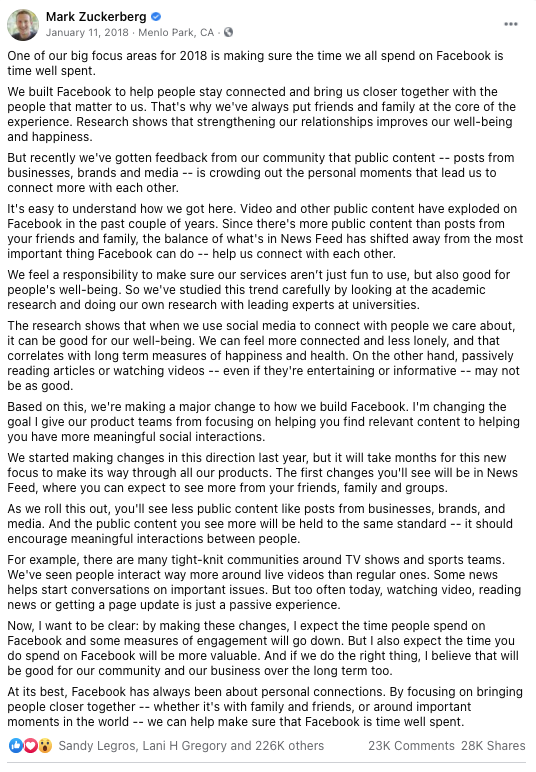
Facebook shifted more toward the user experience model while integrating the auction.
Advertisement
Continue Reading Below
The auction is based on:
- Ad rank.
- Advertiser bid.
- Estimated action rates.
- Ad relevancy and quality.
However, it is still unclear exactly how Facebook’s ad algorithm works.
Eric Sodomka, a research scientist at Facebook that focuses on auctions, shared his first-party insights on how Facebook’s ad algorithm works.
You’ll want to watch this:
Within that presentation, Eric shares how Facebook evaluates content.
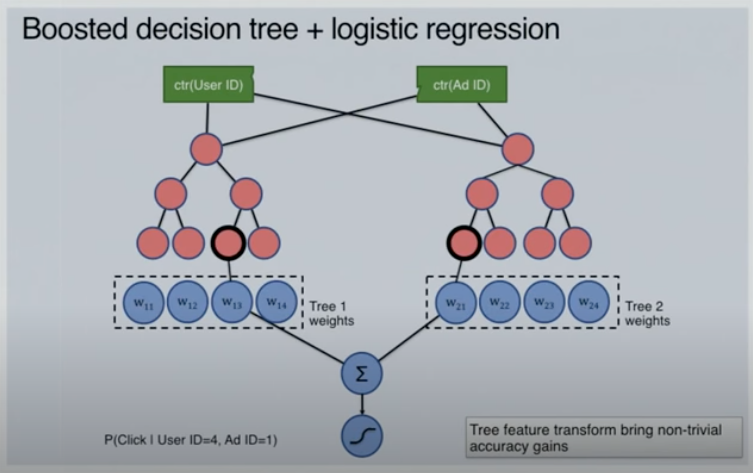
On the left, you’ll see the probability that this specific user will click any ad.
On the right side, you’ll see the probability that a specific user will click this ad.
Facebook uses this predictive data to decide the likelihood that someone will take an action. With Facebook’s flexible analytics architecture, they do test various models outside of this.
If you want to get into the nitty-gritty of it, you’ll want to dive into this research paper, Practical Lessons from Predicting Clicks on Ads at Facebook by Joaquin Quinonero Candela, the Director of Applied Machine Learning at Facebook Research.
6 Types of Facebook Ads
There are six types of Facebook ad formats.
Image
File type: JPG or PNG
Resolution: 1080 x 1080 pixels
File size: 30MD
Facebook image ads allow users to create visuals with static images to drive action.
Here are my secrets to optimizing your Facebook image ads:
- Show examples of customers using your product.
- Try to avoid text. Remember, less is more.
- Stick to a consistent theme if you’re running multiple ads.
- Always use high-resolution images.
Advertisement
Continue Reading Below
Video
File type: MP4, MOV, or GIF
Resolution: 1080 x 1080 pixels
File size: 4GB
Video duration: 1 second to 241 minutes
Facebook video ads give businesses a chance to showcase their brand in sound and motion. These can be seen in the stream, feed, or stories. You also have the option to create a slideshow.
Here are my secrets to optimizing your Facebook video ads:
- Showcase a unique feature, product, or service. You want to tell your story.
- Keep the audience engaged with clips of 15 seconds or less.
- Stick to one message per video. Ask yourself: What action do you want them to take?
Carousel
File type: JPG or PNG
Video file type: MP4, MOV, or GIF
Resolution: 1080 x 1080 pixels
Number of cards: 2-10
Image file size: 30MB
Video file size: 4GB
Facebook carousel ads allow you to display up to 10 images or a video in a single ad. Each image receives its own link.
Here are my secrets to optimizing your Facebook carousel ads:
- Choose a different product on each image pair, each product image with its own landing page link.
- Tell a compelling story that pushes people to swipe for a more interactive format.
- Explain a step-by-step process of how a product or service works.
Advertisement
Continue Reading Below
Instant Experience
Image type: JPG or PNG
Video file type: MP4 or MOV
Size: 1080 pixels x 1920 pixels
Images supported: Up to 20 images
Instant Experience Facebook ads pair with collection ads. Users can watch videos, swipe through carousels, and shop for products in your catalog.
Here are my secrets to optimizing your Facebook collection ads:
- Try to not autoplay two videos at once. It could cause multiple playback issues.
- Skip the captions for videos with Instant Experience ads.
- If you’re using the title-to-pan feature, add a CTA to let users know they can tilt to see more.
Collection
Image type: JPG or PNG
Video file type: MP4, MOV, or GIF
Resolution: 1080 x 1080 pixels
Image file size: 30MB
Video file size: 4GB
Facebook collection ads are paired with Instant Experience ads. The collection ad serves a cover photo or video and four product photos. When a user clicks on a photo, a landing page pops up to drive that Instant Experience feature.
Here are my secrets to optimizing your Facebook collection ads:
- You can allow Facebook to dynamically choose which products you want to be shown. It saves time in the long run.
- Try to stick to product categories with more than 50 products. Facebook forces you to pair a minimum of 4 products, but with the dynamically chosen options, Facebook will serve the most popular or highest likelihood to be purchased.
- Always include a URL parameter to track ad data.
Advertisement
Continue Reading Below
Bonus tip: If you’re unsure how to choose the right Facebook ad objective for your goals, check out Amy Bishop’s article.
Here’s How to Create an Ad on Facebook With Step-by-step Instructions
First things first, before you can create an ad on Facebook, you’ll want to create a Facebook Ads Manager account (if you have a business page).
If you’re not sure if you have an account, try to log into Facebook Ads Manager.
Step 1: Choose a Campaign Objective
Facebook gives you options to select from the following goals.
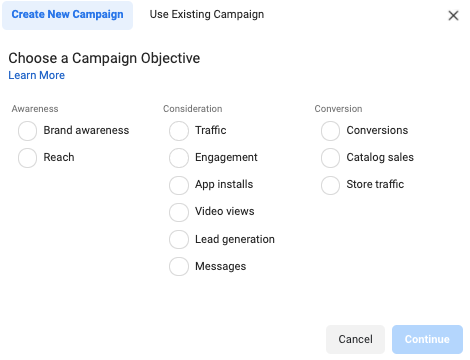
For the purposes of this article, I selected traffic as my goal.
Advertisement
Continue Reading Below
Step 2: Name Your Campaign
After you select your campaign objective, you want to name your campaign along with the ad set and ad.

Step 3: Complete Campaign Details
After you name your campaign, Facebook will give you more campaign details to complete.
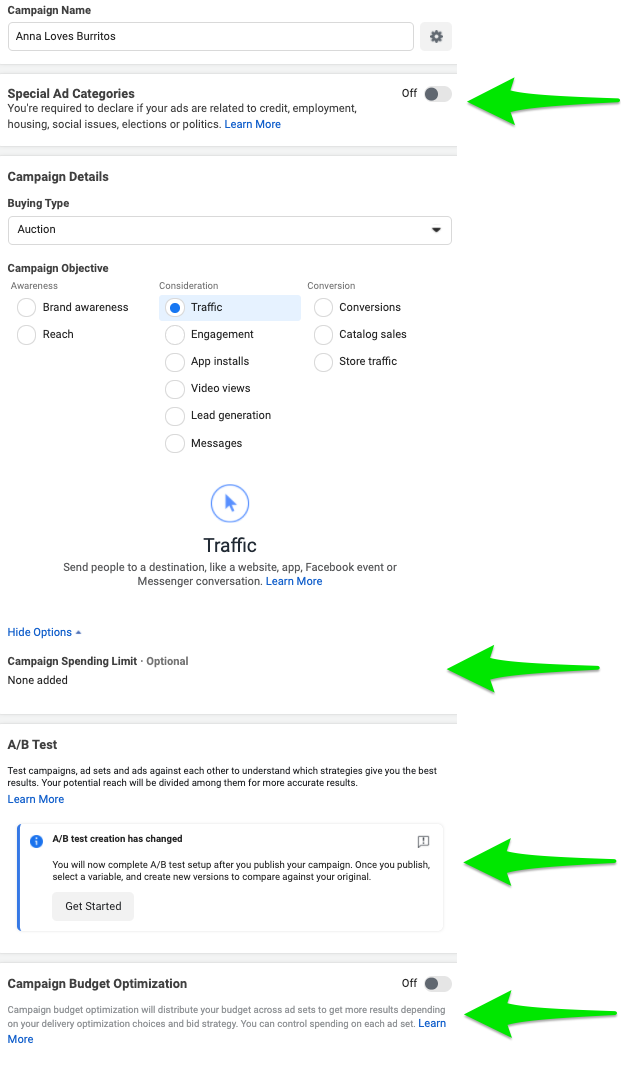
Here’s a quick breakdown of each:
Special Ad Categories
If your ad relates to credit, employment, house, social issues, elections, or politics, you must select this option. Due to the restraints of certain countries, there are different steps Facebook must follow to be legally compliant.
Advertisement
Continue Reading Below
Campaign Spending Limit
Similar to budget optimization, the campaign spending limit stops delivering your ad once that limit is reached. Facebook will send you a notification to let you know the limit has been reached so you’ll have the option to keep it running if you’d like.
A/B Tests
Facebook allows ad managers to test creatives, audience, and placement to uncover the best-performing campaign. If you select this option, Facebook will automatically make this the A of the A/B test.
Campaign Budget Optimization
This allows you to set a budget at a campaign level. In the past, Facebook only allowed users to set this at an ad set level so it caused a lot of complications when allocating budgets to different audiences.
I’d recommend using this if you’re starting a campaign in a learning phase, or easing your campaign management, or if you’re targeting to get more conversions or a lower cost-per-ad. If you’re targeting a super niche audience, you may want to avoid this.
Advertisement
Continue Reading Below
Step 4: Choose Budget, Schedule, Audience, and Delivery
This is my favorite step in creating Facebook ads. It’s where the research and the data begin to come together.
First, you can choose where you want to drive traffic.
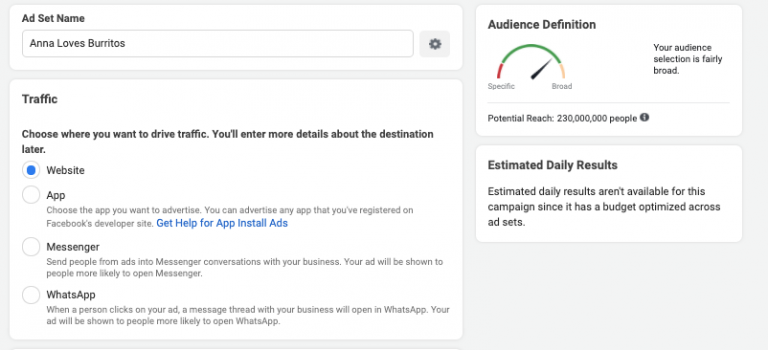
Then, you can toggle dynamic creative on if you want Facebook to automatically generate variations depending on the audience most likely to engage.
You’ll want to pair this with automatic placements that I’ll cover below.
Advertisement
Continue Reading Below
These are my new favorite ad sets from Facebook. Wordstream saw 60% more conversions after using dynamic creative ads in just 30 days.

You can also use this to rotate in an offer style ad feature. This allows you to send automatic reminders, discount codes, and more.
Swish used this to promote a 50% off discount at 7-Eleven stores and saw an increase of 66% of offline sales.
Next, you can choose your budget and schedule.
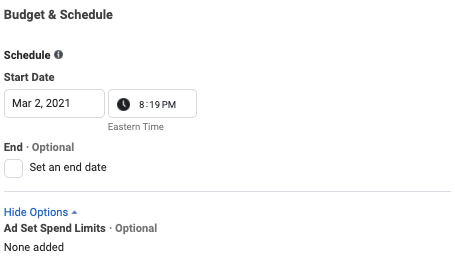
Followed by audience creation.
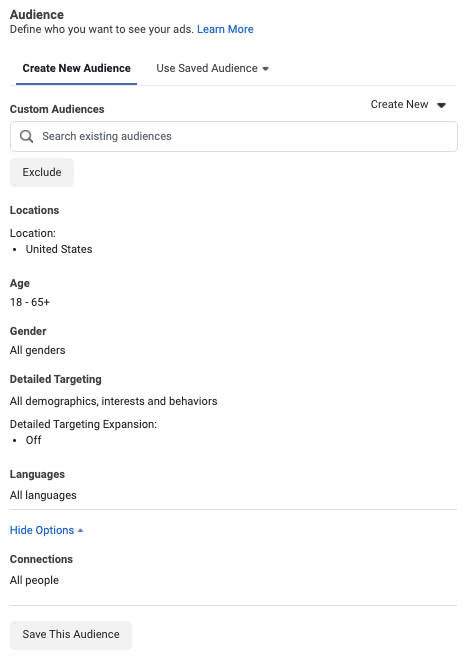
Until you get down to the placements, optimization, and delivery at the bottom.
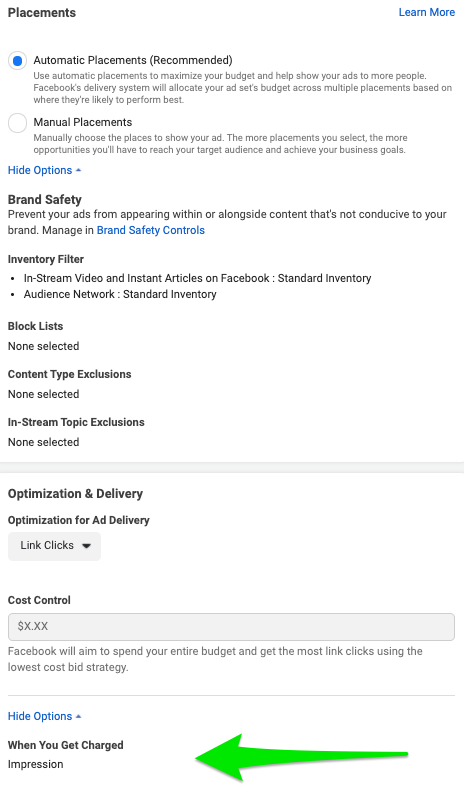
One element you’ll want to remember to check is how you get charged for these Facebook ads.
Advertisement
Continue Reading Below
Facebook is tricky and hides this all the way at the bottom.
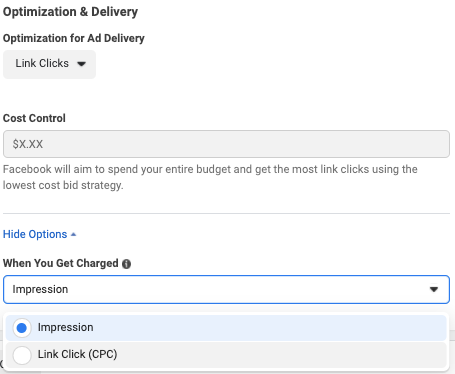
Step 5: Choose Ad Format
You’re on the final stretch! On the last page of the Facebook ad set-up, you have the option to select the format you’d like to structure your ad for users.
This is where your ad type knowledge from above comes in handy.
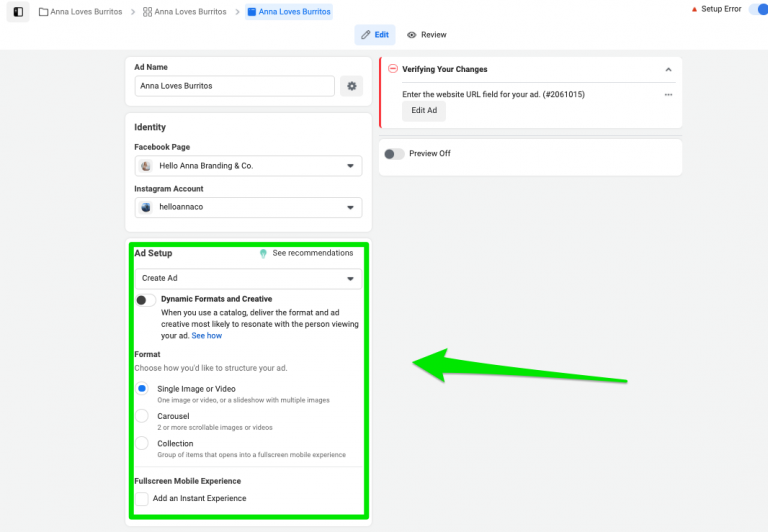
Step 6: Upload Creatives
Now, you can upload your media and add ad copy and a landing page URL.

Step 7: Select Languages
If you’re a global company or a local company targeting other dialects, you will want to add your own transcripts to your ads.
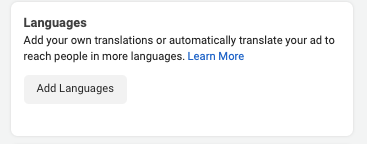
Step 8: Set Up Tracking and URL Parameters
This last step is the most important step. You want to always track your data and select a URL parameter to understand how your ads are converting and what’s motivating users to click.
![]()
Facebook Advertising Is Just Getting Started
Due to the growing lawsuits aimed at Facebook ads and Apple’s stance on security, Facebook is going to look for more ways to generate revenue.
Advertisement
Continue Reading Below
Keep your eyes peeled for Facebook Group ads. Facebook has been silently testing these since late 2019. And, their $10 million Super Bowl ad was dedicated to Facebook Groups.
I smell a new ad type baking in the oven.
With a bigger drive for user experience and more lawsuits, Facebook is going to drop core targeting options slowly. But with this comes more ad options and a greater drive to video.
Until we have more information from Facebook, businesses should continue to work to understand their customers and how best to engage them.
Featured image credit: Paulo Bobita
 seolounge
seolounge